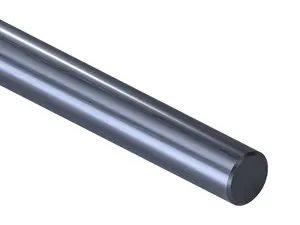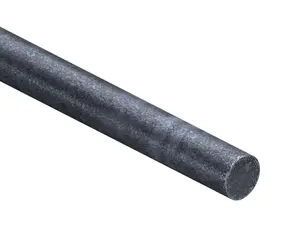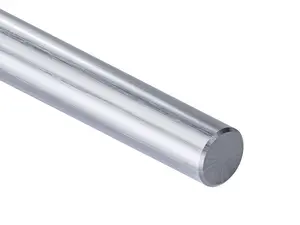Round steel bars are an extremely versatile product that can serve a variety of applications in many fields.
In our offer you will find drawn round bars, which are ideal for applications requiring precise dimensions and a smooth surface. The offer is complemented by hulled round bars, which, thanks to their manufacturing process, are characterized by even greater dimensional precision. Last but not least are hot-rolled round bars, which are strong yet retain great ductility, making them an ideal choice for demanding constructions.
Characteristics of round bars
Round bar is a metallurgical product that is characterized by a uniform geometric form with a circular cross section. It is an element that plays an important role in steel production due to its versatility and mechanical properties.
Drawn round steel bars are produced by a drawing process, in which the material is drawn through a series of dies, gradually reducing its diameter. This process gives the bars an exceptionally smooth surface and better mechanical properties, such as tensile strength and hardness. As a result, the rods feature precise dimensions and excellent structural uniformity.
Hulledround bar differs from others by surface treatment processes. Peeling involves the mechanical removal of the top layer of material, which results in increased dimensional accuracy and better surface quality. As a result, peeled bars are perfectly smooth and free of any surface irregularities or defects.
Hot-rolled round steel bars are produced by a hot-rolling process. The material is heated to the appropriate temperature and then passed through a rolling mill, where it obtains the desired form and dimensions. This process gives the bars a specific surface texture and mechanical properties that are different from those obtained by other manufacturing processes.
The production method of each type of round bar is closely related to its characteristics and final properties. The appropriate choice of technology and raw materials ensures that the final product will meet high quality standards.
Features and advantages of round bars
Features of round bars:
Drawn round bars:
- Precise dimensional accuracy.
- Exceptionally smooth surface.
- Structural uniformity.
Hulled round bars:
- Excellent surface quality. o Removal of unevenness and external defects.
- Improved dimensional accuracy.
Hot-rolled round bars:
- Specific surface texture.
- Excellent plastic properties.
- Fast manufacturing process enabling high production volumes.
Advantages of round bars:
Drawn round bars:
- Increased tensile strength.
- Less risk of surface defects.
- Ideal for applications requiring precision.
Hulled round bars:
- Minimization of internal stresses.
- Reduced risk of surface corrosion.
- Ideal for applications where surface quality is critical.
Hot-rolled round bars:
- Flexibility in forming and machining.
- Natural resistance to external influences due to specific surface texture.
Steel grades
We offer round bars made of 11SMN30 (1.0715), 11SMN30+C (1.0715), 16/20MNCR5 (1.7131/1.7147), 16/20MNCRS5 (1.7139/1.7149) and 16MNCRS5 (1.7139) steels.
11SMN30 (1.0715)
Features:
- This is an automatic steel with a low carbon content and added sulfur for easier cutting.
Advantages:
- Excellent cutting properties.
- Good mechanical properties.
- Possibility of obtaining smooth surfaces after machining.
Disadvantages:
- Lower strength than some other steels.
- Potential risk of corrosion under adverse conditions.
11SMN30+C (1.0715)
Features:
- This is essentially the same steel as 11SMN30, but is additionally annealed to improve its properties.
Advantages:
- Improved cutting properties compared to standard 11SMN30.
- Better ductility.
- More homogeneous structure.
Disadvantages:
- May require more complicated heat treatment processes.
16/20MNCR5 (1.7131/1.7147)
Features:
- This is an alloy steel containing chromium and manganese, which provide it with excellent hardening properties.
Advantages:
- High hardness after hardening.
- Good fatigue strength.
- Ability to achieve high tensile strength.
Disadvantages:
- Potential brittleness after improper heat treatment.
16/20MNCRS5 (1.7139/1.7149)
Features:
- Similar to 16/20MNCR5, but with added sulfur for easier cutting.
Advantages:
- Cutting properties better than 16/20MNCR5.
- Retains excellent hardening properties.
- Increased ductility compared to 16/20MNCR5.
Disadvantages:
- Lower corrosion resistance than sulfur-free versions.
16MNCRS5 (1.7139)
Features:
- This is an alloy steel with manganese, chromium and added sulfur.
Advantages:
- Good cutting properties.
- Excellent ductility.
- High strength and hardness after appropriate heat treatment.
Disadvantages:
- Need for thorough heat treatment to achieve optimum properties.
Applications of round bars
Round steel bars are widely used in many industrial sectors because of their strength, durability and ability to conduct pressure along their length. These properties make them indispensable in structures, machinery and many other engineering applications.
Drawn bars are characterized by an even and smooth surface and improved mechanical properties compared to other bars. Such parts are often used where precise dimensions and highly uniform structure are required, such as precision shafts, high-speed machine components or components in the aerospace and automotive industries.
Hulled round bars are preferred in structures requiring minimal surface treatment and excellent surface quality, such as in the manufacture of pistons, shafts and hydraulic components.
Hot-rolled round bars are typically used where precise surface treatment is not required. Such bars are ideal for building structures, machine manufacturing or as intermediates in further processing, where their initial mechanical and structural properties are more important than surface aesthetics.
Advice for investors
- Determine your requirements - choose the type of bar suitable for the specifics of your project. Different manufacturing processes affect bar properties that can be crucial to your construction.
- Check the grade of steel - it determines many properties, such as strength, corrosion resistance and machinability. Choose the grade that best meets the requirements of your project.
- Quality testing - make sure the supplier offers quality certification, confirming that it meets industry standards and technical parameters for the bar you choose.
- Verify the supplier - check the supplier's experience and references. A reliable supplier will ensure continuity of supply and product quality.
- Technical consultation - use the supplier's expertise to get advice on bar selection, processing or applications. Experts can help optimize your purchase.
- Customizing your order - make sure the supplier is flexible and willing to adapt to your specific needs, both in terms of quantity and technology.
Storage of round bars
- Horizontal storage - round steel bars should be stored horizontally on stable sleepers to ensure even weight distribution.
- Protection against corrosion - in areas of high humidity, it is worthwhile to use materials that protect against corrosion, such as oils or anti-corrosion coatings.
- Protection from mechanical damage - to avoid dents or scratches, the round bar should be separated from other materials, especially those with sharp edges.
- Protection from the elements - as far as possible, rods should be stored inside warehouses. If outdoor storage is necessary, the bars should be shielded from direct sunlight, rain or snow.
- Quality control - regular inspections of the condition of stored bars are the key to detecting and eliminating possible problems such as corrosion or deformation.
Did you know
- The first round steel bars were manufactured by hand by forging steel. This process has changed significantly with the industrial revolution and the introduction of rolling machines.
- Round steel bars are often used in physical and engineering experiments in stress and strain analysis.
- In addition to industrial applications, round bars are also used in art and sculpture. The artistic use of rods allows the creation of modern and innovative forms.
- The longest round bar rolled in a single piece was more than 103 meters long, made possible by specialized rolling and cooling techniques.
- Steel rods, especially those made of stainless steel, are often used in medicine, for example in the manufacture of surgical instruments or in orthopedics as implants.
Round bars - why with us?
Moris steel wholesaler offers a very wide selection of round bars, guaranteeing the highest quality products and their precise matching to the customer's technical specifications. Our team of experts provides professional service and advice at every stage of cooperation. For the convenience of our customers, we offer a variety of flexible delivery options to suit the individual needs of each company.
We invite you to explore our wide range of round steel bars, which have been carefully selected to meet your expectations in terms of both quality and price.
FAQ
How much does a steel bar weigh?
The weight of a steel bar depends on a number of factors, such as its length, diameter (or width, in the case of square bars) and the density of the steel from which it is made.
Steel has a density of about 7.85 g/cm³. To calculate the weight of a bar, you can use the following formula:
weight = length x transverse area x density of steel
The transverse area for a round bar is calculated from the formula:
area = Pi x (diameter/2)^2
Whereas for a square bar:
area = side^2
For example, for a steel bar with a length of 1 meter and a diameter of 1 cm (that is, a radius of 0.5 cm), the calculation would look like this:
area = 3.14 x (0.5 cm)^2 = 0.785 cm²
Weight = 1 m x 0.785 cm² x 7.85 g/cm³ = 61.67 g
Note that these calculations are approximate, as they do not take into account some factors, such as small irregularities in the density of the steel.



